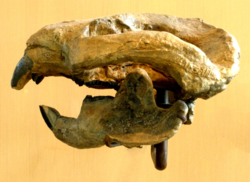Taeniolabis
|
Taeniolabis Temporal range: Paleocene |
|
|---|---|
 |
|
| Taeniolabis taoensis | |
| Scientific classification | |
| Kingdom: | Animalia |
| Phylum: | Chordata |
| Class: | Mammalia |
| Order: | Multituberculata |
| Superfamily: | Taeniolabidoidea |
| Genus: |
Taeniolabis Cope, 1882 |
| Species | |
|
|
Taeniolabis ("Ribbon Lips") is a genus of extinct multituberculate mammal from the Paleocene of North America.
It is the largest known member of the extinct order Multituberculata, as well as the largest non-therian mammal: T. taoensis possibly exceeds 100 kg.
It is within the suborder of Cimolodonta and is a member of the superfamily Taeniolabidoidea. The genus was named by Edward Drinker Cope in 1882. Species have also been placed with the genera Catopsalis and Polymastodon Cope, 1882.
The species Taeniolabis lamberti was named by N.B. Simmons in 1987. It has been found in the Puercan (Paleocene)-age Tullock Formation of Montana. It is not quite as large as T. taoensis, but still a hefty size for a multituberculate.
The species Taeniolabis taoensis was named by Cope E.D. in 1882. It is also known as Catopsalis pollux (Cope, 1882); Polymastodon attenuatus (Cope, 1885); P. latimolis Cope, 1885; P. selenodus Osborn H.F. and Earle C., 1895; P. taoensis (Cope, 1882); T. attetuatus; T. scalper (Cope 1884); T. sulcatus (Cope 1882a); T. triserialis (Granger & Simpson, 1929). They are found in the Puercan-age Nacimiento Formation of New Mexico and Wyoming and in the Ravenscrag Formation of Saskatchewan. This species had a 6 in. (16 cm) long skull. It was a real heavyweight; the largest known multituberculate, this creature was as big as the giant beaver.
...
Wikipedia
